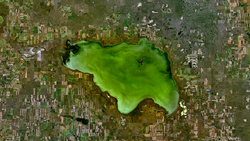Old Wives Lake
| Old Wives Lake | |
|---|---|

Old Wives Lake, as seen from space.
|
|
| Location | Saskatchewan |
| Coordinates | 50°05′N 106°00′W / 50.083°N 106.000°WCoordinates: 50°05′N 106°00′W / 50.083°N 106.000°W |
| Type | saline |
| Primary inflows | Wood River |
| Basin countries | Canada |
Old Wives Lake is a shallow saline lake in south central Saskatchewan, Canada, about 30 km southwest of Moose Jaw. The lake is fed by the Wood River but seasonal water relatively flattened the terrain, and as such results in significant mudflats. A Migratory Bird Sanctuary was established at the lake on March 9, 1925. This lake, in conjunction with Reed Lake and Chaplin Lake, forms a site of hemispheric importance in the Western Hemisphere Shorebird Reserve Network. It was designated in April 1997, and is "one of the most important inland sites for migratory birds in North America". A variety of First Nations oral traditions explain the origin of the lake's name. At various times during the lake's human history, it has attracted interest from several First Nations tribes, duck hunters, military trainers, sodium sulfate producers, conservationists and birdwatchers.
A town of the same name (Old Wives) is located north of the lake on Highway 363.
According to a Cree tradition recounted by Métis guides accompanying the North West Mounted Police in 1874, sometime around 1840 a band of Cree hunters followed a herd of bison into Blackfoot territory and made camp near the lake. Blackfoot scouts discovered this band and attacked. Although the Cree were able to defend themselves, they anticipated an attack by a larger Blackfoot war party the next morning. The older women volunteered to stay behind to tend the fires through the night in the hope of fooling the Blackfoot into believing that they were not abandoning their camp to escape. Using this diversion as cover, the rest of the Cree successfully fled back to their home territory in the Qu'Appelle valley. When the Blackfoot arrived that morning they found only the old women, whom the Blackfoot killed in vengeance. This commonly recited version of the lake's naming has been commemorated by a historical marker situated beside Highway 2 near the lake. A variant telling of this narrative states that the Blackfoot warriors were so impressed by the women's courage that they left them alone and allowed them to rejoin their own people. Another First Nations oral tradition describes how a band of Assiniboine fleeing from pursuing Blackfoot warriors abandoned the old women in their band who could not keep pace with everyone else. The women continued their effort to escape by wading across the lake. However, they misjudged the water's depth and drowned. An Assiniboine tradition associates the name with a battle which occurred at the lake around the beginning of the 19th century in which Assiniboines vanquished their Blackfoot enemies. According to some First Nations traditions, the spirits of the dead women continue to haunt a small island in the lake from which their voices can be heard at night.
...
Wikipedia
